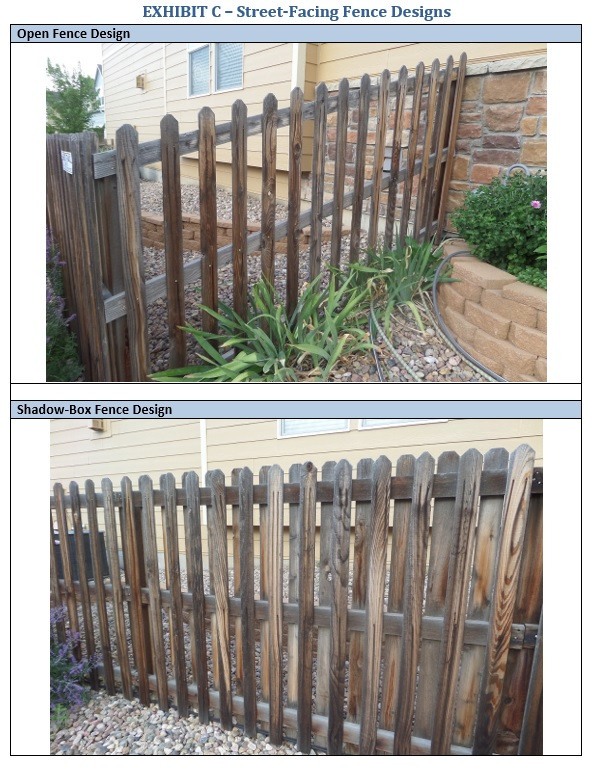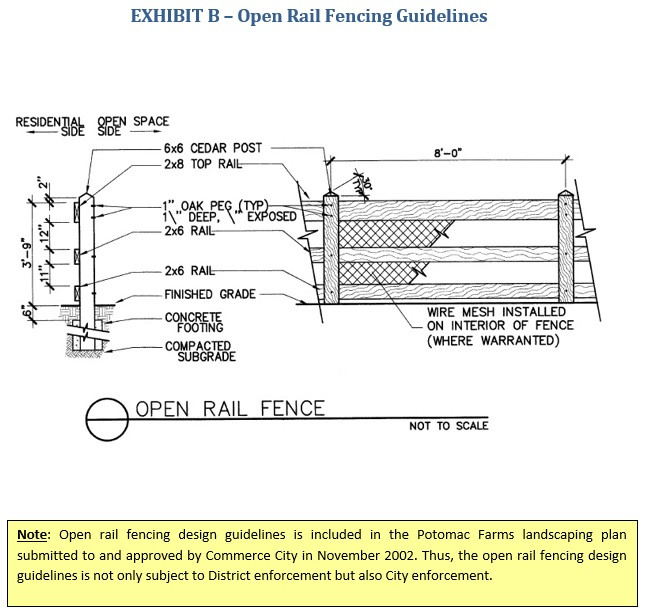2.36. FENCES.
2.36.1. General. Owners must install and maintain fencing around the backyard lot lines. Owners are not required to install wing fences (the fence on either side of the house that faces the street and extends from the house to the property line). All such fencing is subject to the design restrictions provided throughout the rest of this section. No more than one fence line can be installed on any property line (i.e. double fencing is not allowed). Consequently, all fences (with the exception of fences bordering District-owned/maintained land) are jointly owned by the owners of both Lots.
2.36.2. District-Owned Fencing. District-owned fences, walls and columns (individually and collectively "Fences") located along or abutting Owner Lot lines or public or private streets may not be removed, replaced, stained or painted a different color or altered, including adding a gate, without approval of the Committee. If any District Fences which are located upon an Owner's Lot are damaged or destroyed by Owner or Owner's agents, guests, or tenants, the Owner shall repair and recondition the same at the Owner's expense.
2.36.3. Drainage. It is important to remember that certain drainage patterns may exist along or under Fence locations. When constructing a Fence, be sure to provide for a 2’’ to 3’’ space between the bottom of the Fence and the ground elevation so as not to block these drainage patterns.
2.36.4. Design. Fences, other than those described below, may not be constructed without Committee approval. Removal of fences also requires Committee approval. Front yard fencing is not permitted. All Fences must adhere to any sight triangle regulations of the City. Committee approval is not required for rear yard fences constructed in accordance with the following requirements:
2.36.4.1. Rear/Side Yard Privacy Fences. Fences shall be installed on the rear yard property lines of each lot. Rear/Side Yard Privacy Fences must be constructed with the 2’x 4’ framing and 4’ x 4’posts on the constructing Owner's lot and fence height shall not exceed 6 feet. Side Yard Privacy Fences may not extend toward the front of a lot past the wing fence.
2.36.4.2. Open Rail Fences. All rear/side yard fences adjacent to Common Areas shall be installed on the property lines between the lot and the Common Area and shall be constructed in accordance with the design specifications provided in Exhibit B. Wire mesh may be installed on the interior (the side of the fence which closest to the Home) of an Open Rail Fence so long as such wire mesh is not higher than the top rail of said Fence. Open rail fencing shall be 3 feet in height.
2.36.4.3. Shadowbox Fencing. Shadowbox style fencing shall be 5 feet tall and shall be constructed in accordance with the design specifications provided in Exhibit C. Pickets must be 1in x 4in x 5ft. Wire mesh may be installed on the interior (the side of the fence which closest to the Home) of the fencing so long as such wire mesh is not higher than the top rail of said Fence.
2.36.4.4. Open Picket Fencing. Open Picket style fencing shall be 5 feet tall and shall be constructed in accordance with the design specifications provided in Exhibit C. Spacing between pickets shall be between 1 ½ inches and 2 inches wide. Pickets must be 1in x 4in x 5ft. Wire mesh may be installed on the interior (the side of the fence which closest to the Home) of the fencing so long as such wire mesh is not higher than the top rail of said Fence.
2.36.4.5. Wing Fencing: Wing fences shall be set back from the front face of the house. Prior to installing or moving any wing fences, Committee approval must be obtained regarding the proposed set-back distance of any wing fence.
2.36.4.6. Material and Color: All perimeter fencing shall be constructed of wood. Vinyl, composite, stone or brick perimeter fencing is prohibited. Owners are not required to stain their fences. However, once fences are stained, Owners must maintain the fence stain color in good condition (free from peeling and fading). Fences may not be painted. Approved fence stain colors are provided in Exhibit E. If the Owner wants to stain the fence using a color not listed in Exhibit E, Committee approval is required.
2.36.5. Corner Lot Fencing. Fences on lots adjacent to public or private streets shall not be constructed within the rights-of-way or side yard easements adjacent to such public or private streets and, therefore, must be set back a minimum of four feet from the sidewalk. Fencing bordering streets (that is not District-owned fencing) must comply with one of the following two fence designs: (1) Shadowbox fencing or (3) Open picket fencing (see Exhibit C).
2.36.6. Double Fences. Two separate fence structures (i.e. separate posts and rails) bordering the same property line is not permitted. A two-sided privacy fence requires Committee approval. Pickets must share the same posts and side rails. Rear yard privacy fences may be constructed as a single row of posts with pickets on both sides..
2.36.7. Fences for Screening Located Within Lot Line. Must be an integral part of the landscape design.
2.36.8. Gates. Committee approval is required before installing any gates in any fence lines.
2.36.9. Wire Fencing. Except for the wire mesh approved for Open Rail Fencing and chain-link dog runs approved by the Committee and constructed in accordance with Section 2.32 hereof, no plastic or metal chicken wire, hog wire, barbed wire, chain links, or strand wire will be allowed unless committee approval is obtained.
2.36.10. Drainage. Fencing should be installed with a 2-3" gap at the bottom to allow for proper drainage into and through swales.
2.36.11. Maintenance Responsibility. All fence lines shall be maintained free from significant damage, warping and stains (including graffiti). Fence posts shall be properly anchored in the ground. Missing or damaged fence pickets, caps and runner boards shall be promptly replaced. Land grading shall be adequately maintained and managed to ensure dirt and sand does not build up against the fence line (causing long-term warping and damage to the fence line).

